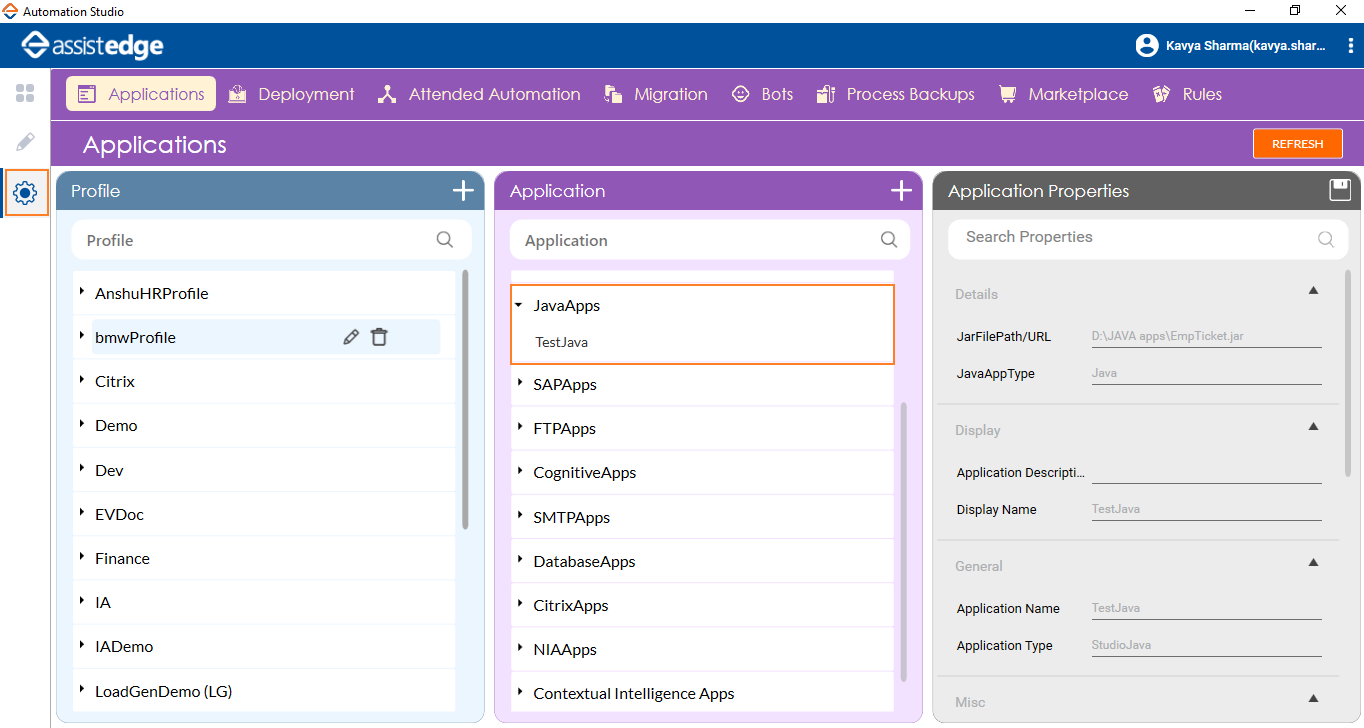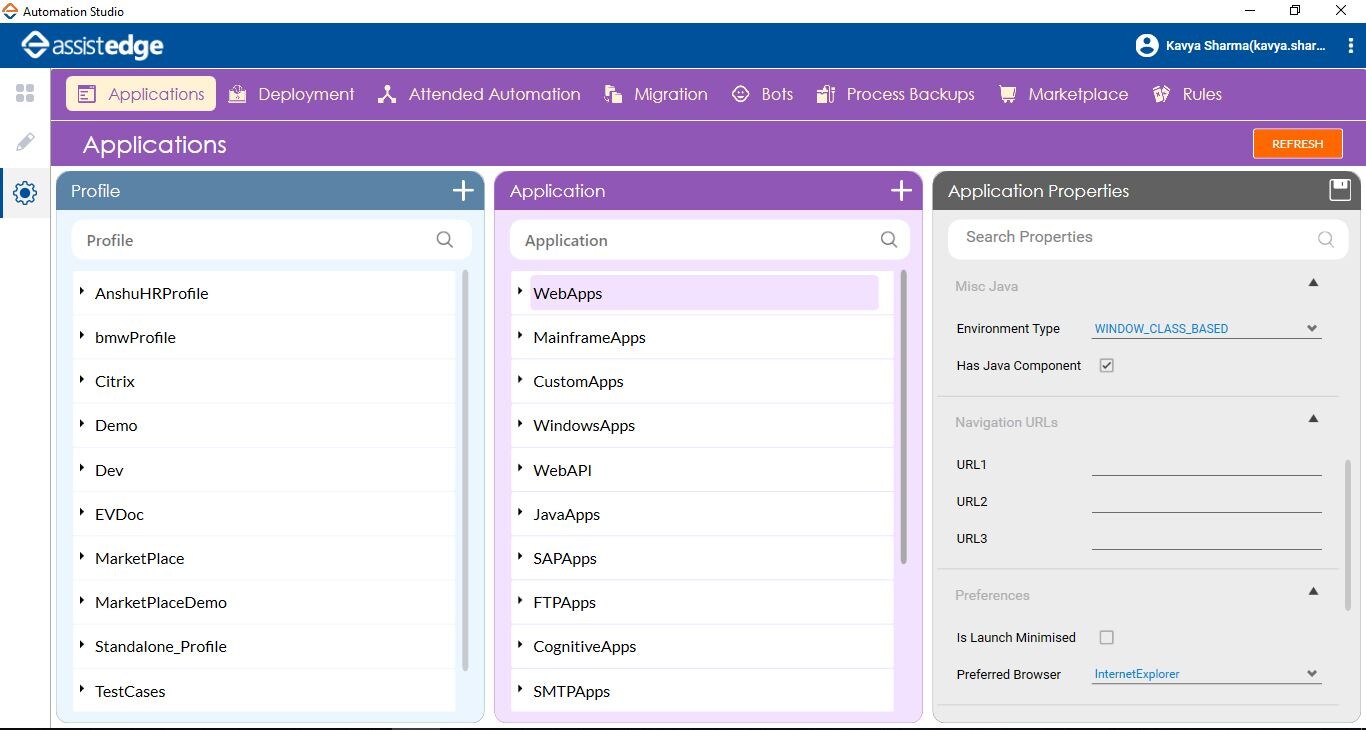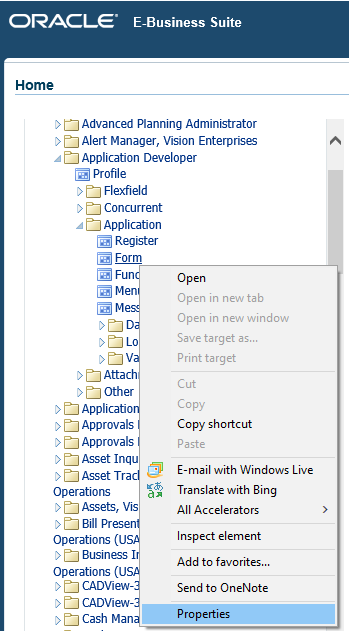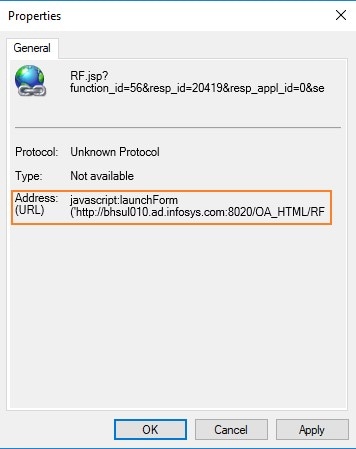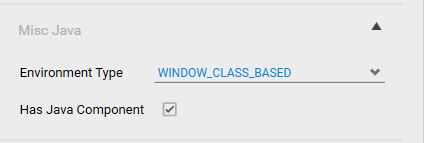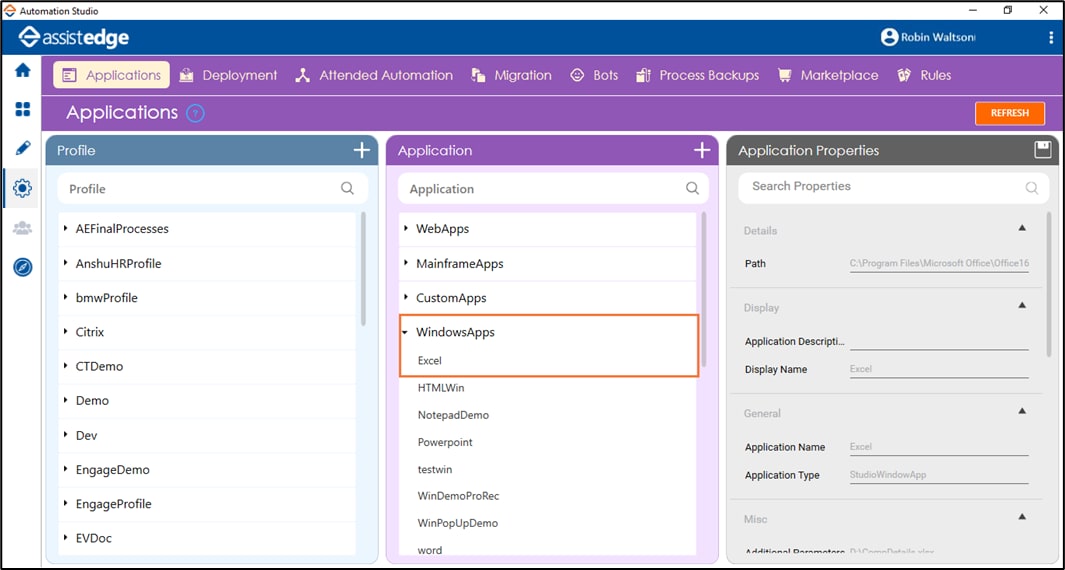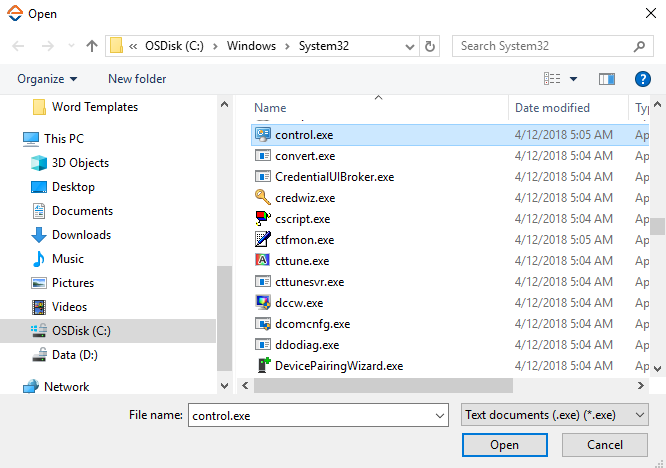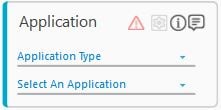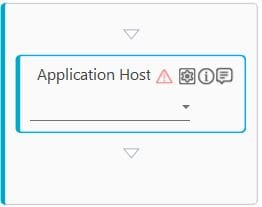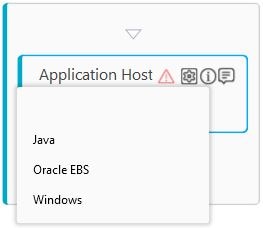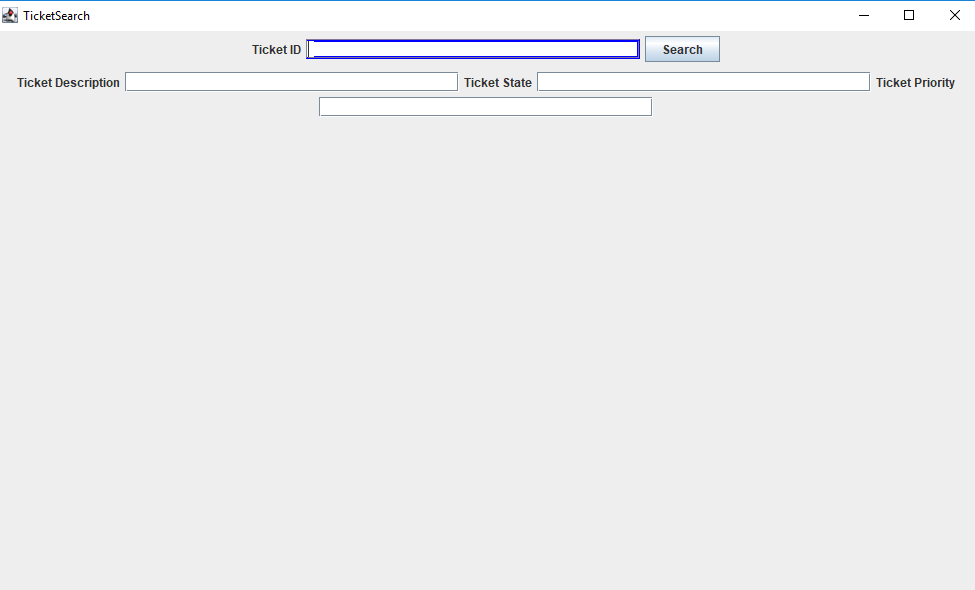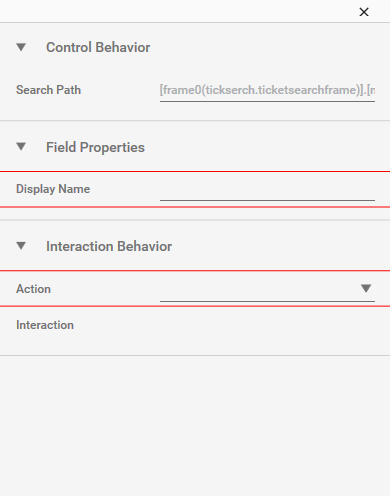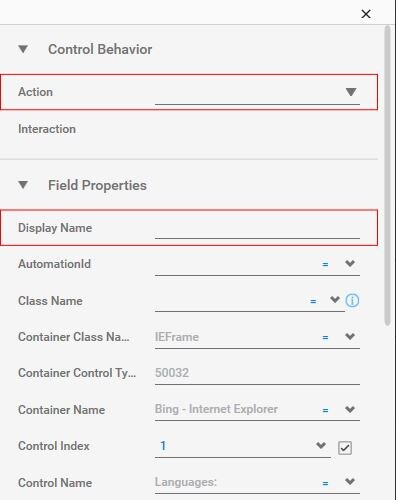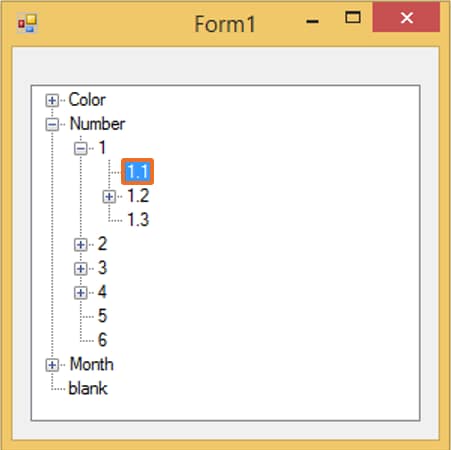Application Host
This activity helps to automate UI elements of a Windows/JAVA based host application or a pop-up window of the host application that may not get captured or identified using other methods like the Multimodal Interface.
Automation Studio supports automation of the Java-based Oracle Forms in a codeless manner with the help of out of box adapters. For an Oracle EBS based application, only Application Host activity is available that must be used to configure the related automation process workflow.
|
NOTE: |
|
This activity lets you attach a plug in of the selected application type to the configured and launched host application to identify the UI elements.
Prerequisite: Configuring Application
You must configure the intended host application in Automation Studio before you start configuring the steps of automation process workflow. This establishes the connection between the required application and Automation Studio to perform the automation.
Below are the minimum required properties for configuring the intended host application. If you want to define remaining properties, refer WindowsApps for windows applications, WebApps for Oracle EBS application or any other web application and JavaApps for Windows and Java applications respectively.
|
Requirement |
Description |
||
| Java Application |
Install Java (JDK, v ) on the system where the automation process workflow is designed and on the system where the automation would run. Configure Java application:
|
||
| Oracle EBS Application/Other Web Application |
Configure Oracle EBS application/ Other Web application:
|
||
| Windows application |
Configure Windows application:
The windows application is configured.
|
Using Application Host Activity
- In an automation process workflow, click Process Components in the Canvas Tools pane to expand the tool and view the associated activities.
- Drag the Application activity and drop on to the Flowchart designer on the Canvas. The validation error symbol disappears when required inputs are provided.
- In the Application Type list, select the type of configured host application you want to automate. For example, select WebApps for Siebel or Oracle EBS applications, WindowsApps for applications like Notepad or CMD and JavaApps for Java applications. You must have at least one application added for it to appears in the list.
- In the Select An Application list, select the configured host application. Alternatively, you can add the required host application at this point of time. To add the application, click any of the links below:
- Java Applications - Lets you configure the Java applications.
- Oracle EBS Applications - Lets you configure the Oracle EBS and other web applications like Siebel.
- Windows Applications - Lets you configure the Windows applications.
- Once the application is configured and the login steps are captured (if required), in the Menu bar, click Test Run drop down, and then click Setup Environment to setup and launch the configured application. It helps to launch the application using automation Studio. Before you start capturing automation steps using this activity, make sure that the intended application is open using the Automation Studio.
- Double click the Application activity, drag the Application Host and drop inside the Application activity. The validation error symbol disappears when required inputs are provided.
- From the drop down list, select the type you host application you want to automate. Available options are - Java, Oracle EBS and Windows. A typical web application can be automated in the Windows category.
- Click the
 (Settings) icon of the Application Host activity to attach the plug in based on the type of selected host application. A dialog box appears where you can define configurations related to the attached plug in.
(Settings) icon of the Application Host activity to attach the plug in based on the type of selected host application. A dialog box appears where you can define configurations related to the attached plug in.
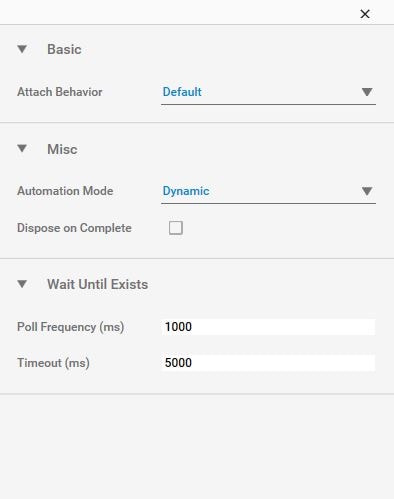
- In the Attach Behavior list of the Basics category, select the identification criteria to identify the required host application window to which the plug in must be attached. Available options are:
- Default -
- Equals - Selects the window based on the exact match with the window name.
- Contains - Selects the window based on the text present in the window name.
- StartsWith - Selects the window based on the starting text of the window name.
- EndsWith - Selects the window based on the text with which the window name ends.
- In the Window Title field, enter the window name of the host application to which the plugin must be attached. This field is available only if the Attach Behavior selected is Equals, Contains, StartsWith or EndsWith. For example, if the name of the Oracle Form is Oracle Applications – AUTOSC, select the Attach Behavior as StartsWith and the enter the Window Title as Oracle.
- In the Application Mode list, select Dynamic or Static depending upon the type of UI element to be extracted while performing the automation. This field is available only if the host application type is Oracle EBS.
- Select the Dispose on Complete check box in the Misc category if you want to close the application window once the automation is completed.
- In the Wait Until Exists category you can configure the time for the plug in to wait until the UI element is found. You can use this to avoid any delay in the page loading time. :
- In the Poll Frequency (ms) field, enter the frequency of checking the availability of the UI element. The time must be entered in milliseconds.
- In the Timeout (ms) field, enter the wait time for the plug in until the UI element is found or identified that it does not exists. The time must be entered in milliseconds.
- Close the dialog box to save the plug in configurations.
- Double click to open the Application Host activity block.
- Click ADD to add the Application Control activity. Alternatively, you can drag the Application Control activity from the Canvas Tools pane, and drop inside the Application Host activity.
- Click the
 (Field Configuration) icon. Manually bring the application window in focus. Click any of the links below for step by step guide to automate the UI elements of each of the host application type:
(Field Configuration) icon. Manually bring the application window in focus. Click any of the links below for step by step guide to automate the UI elements of each of the host application type:
- Java - Lets you automate UI elements of a Java application
- Oracle_EBS - Lets you automate UI elements of a Java based Oracle EBS application
- Windows - Lets you automate Windows and Web applications
Java
- Hover over the field that you want to capture. The field gets highlighted with the blue box.
- Click the highlighted area. A dialog box appears where you can configure the details related to the captured UI element. The search path of the component and the window name are auto filled. The fields that are mandatory are highlighted with the red box.
- In the Action list, select the action that you want to perform on the captured area. Other fields change depending on the selection from the list. Enter details of all the mandatory fields and other relevant fields as per your requirement. Refer Windows_Application_Field_Descriptions table to know more about the available fields and their respective properties.
- Close the dialog box. The Save Confirmation message box appears.
- Click YES to save the entered details. Click NO to exit the message box without saving the entered details and to re-configure the required details.
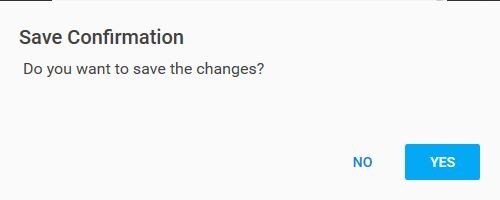
- You need to add the Application Control activity for every UI element you want to capture. Repeat steps 16 and 17 to capture all the UI elements involved in the automation process workflow. You can edit the configuration by clicking the
 (Settings) icon of the Application Control activity.
(Settings) icon of the Application Control activity.
The Java application host is configured.
Oracle EBS
- Hover over the application window to start capturing the automation steps that you want to perform in the Oracle EBS application. The area that you can capture gets highlighted with a blue box.
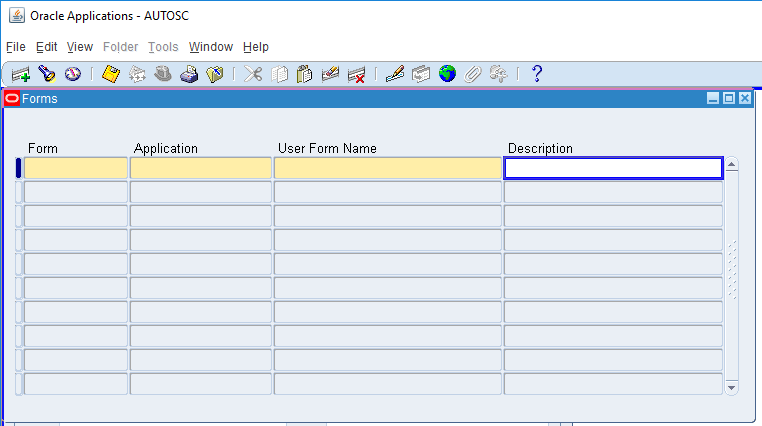
- Click the intended area from where you want to extract the Id of the UI element. A dialog box appears where you can configure the details related to the captured UI element. The Id of the component and the window name are auto filled. The fields that are mandatory are highlighted with red box.
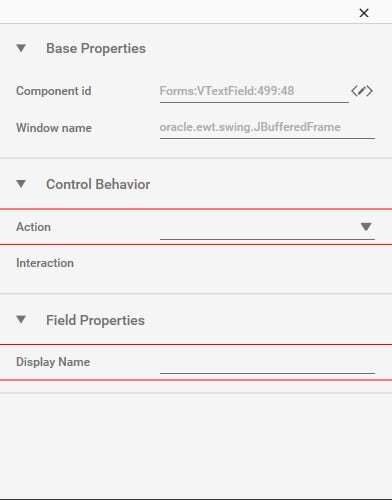
- In the Action list, select the action that you want to perform on the captured area. Other fields change depending on the selection from the list. Enter details of all the mandatory fields and other relevant fields as per your requirement. Refer Oracle_EBS_Application_Field_Descriptions table to know more about the available fields and their respective properties.
- Close the dialog box. The Save Confirmation message box appears.
- Click YES to save the entered details. Click NO to exit the message box without saving the entered details.

- You need to add the Application Control activity for every UI element you want to capture. Repeat steps 16 and 18 to capture all the UI elements involved in the automation process workflow. You can edit the configuration by clicking the
 (Settings) icon of the Application Control activity.
(Settings) icon of the Application Control activity.
The Oracle EBS application is automated.
|
NOTE: |
You must Close Environment and then Reset Environment every time you want to Test Run a process workflow, else, error is received or the test run fails. |
Oracle EBS Application Field Descriptions
|
Property Name |
Usage |
|
Base Properties |
|
|
Component id |
The Id of the selected UI element that gets auto filled on selection of the UI element. You can replace the static part of the component Id with an argument to make a dynamic part of the component Id. To create dynamic component Id: Click the (Configure) icon. The Dynamic ComponentId Creator dialog box opens.
|
|
Window name |
The name of the window of the selected UI element. |
|
Control Behavior |
|
|
Action |
It is the action or the interaction that can be performed on the Oracle EBS application depending on the type of UI element as per the requirement. Available options are:
|
|
Interaction |
The corresponding interaction set against the selected action. |
|
Appears for Action that require input index for execution. |
|
|
Index |
The index of the UI element where you want to perform the selected Action on the Oracle EBS Form such as 3, 5 and so on. |
|
Appears for Action that require input value for execution. |
|
|
Value |
The value of the UI element where you want to perform the selected Action on the Oracle EBS Form such as the tab name, tool bar item name and so on. |
|
Appears only if Action selected is Select grid row. |
|
|
Row Number |
The row number that must be selected. |
|
Appears only if Action selected is Select Listview item by index. |
|
|
Item Index |
The index of the item that must be selected from the list-view (drop down list). |
|
Appears only if Action selected is Set Text, Select Choicebox By Value, and Select RadioButton By Text |
|
|
Text |
The user input to be specified. You must define a parameter in the Parameter bar to use this option. Select the Is Default Value check-box, and enter the input value, if you want to set a default value. |
|
Appears only if Action selected is Set CheckBox Status. |
|
|
IsSelected |
Signifies the status of the check box. You must define a parameter in the Parameter bar to use this option. Select the Is Default Value check-box, and enter the status manually, if you want to set a default value. |
|
Field Properties |
|
|
Display Name |
User specified display name of the windows element selected. |
|
Appears for Action that return a value such as actions related to Get and Is interactions. |
|
|
Is C-View |
Is applicable only for AssistEdge Engage. If selected, the field configuration captured in Automation Studio is visible in the Engage C-View tab. |
|
Variable Name |
User defined name of the variable that stores the captured or returned value. You can define the variable name here itself or predefine it in the Parameter bar. |
|
Variable Type |
Type of the variable defined. Available options are: Text Numeric Decimal Boolean Data Table |
Windows
- Press the Ctrl key and hover over the windows/web application to start capturing the automation steps that you want to perform in the Windows application. The area that you can capture gets highlighted with a red box.
- While pressing the Ctrl button click the intended area. A dialog box appears where you can configure the details related to the captured UI element. The fields that are mandatory are highlighted with red box.
- In the Action list, select the action that you want to perform on the captured area. Other fields change depending on the selection from the list. Enter details of all the mandatory fields and other relevant fields as per your requirement. Refer Windows_Application_Field_Descriptions table to know more about the available fields and their respective properties.
- Close the dialog box. The Save Confirmation message box appears. Click YES to save the entered details. Click NO to exit the message box without saving the entered details.

- You need to add the Application Control activity for every UI element you want to capture. Repeat steps 16 and 17 to capture all the UI elements involved in the automation process workflow. You can edit the configuration by clicking the
 (Settings) icon of the Application Control activity.
(Settings) icon of the Application Control activity.
The Windows application host is configured.
Windows Application Field Descriptions
|
Property Name |
Usage |
|
Control Behavior |
|
|
Action |
The applicable action or interaction that can be performed on the selected UI element. The available options change as per the type of host application being automated:
|
|
Interaction |
The corresponding interaction class name auto populated against the selected action. |
|
Interaction |
The interaction or the action type corresponding to the selected interaction. |
|
Appears if Action selected is Legacy Interaction. |
|
|
Action Type |
The interaction or the action type corresponding to the legacy interaction. |
|
Key |
Appears if Action selected is Keyboard Input. The single key set as input from the keyboard. |
|
Key |
Appears if Action selected is Keyboard Input and Interaction selected is DoubleKeys. The second key which is set as input from the keyboard along with the first key. |
|
Key |
Appears if Action selected is Keyboard Input and Interaction selected is TripleKeys. The third key which is set as input from the keyboard along with the first and the second key. |
|
Text |
Appears if Action selected is Keyboard Input and Interaction selected is TextEntry. Allows user input as a text. |
|
Mouse Action |
Appears if Action selected is Mouse Click. Allows user input using the mouse. Available options are:
|
|
Field Properties |
|
|
Display Name |
User specified display name of the windows element selected. |
|
AutomationId |
Unique identifier for the automation element in the automation tree. See Handling Dynamic Controls section to know more about the usage of this field. |
|
Class Name |
Class name of the UI element as defined by the UI element developer. See Handling Dynamic Controls section to know more about the usage of this field. |
|
Container Class Name |
Container class name of the UI element as defined by the developer. See Handling Dynamic Controls section to know more about the usage of this field. |
|
Container Control Type |
Control type of the container of the UI element as defined by the UI element developer. |
|
Container Name |
Container name of the UI element as defined by the developer. See Handling Dynamic Controls section to know more about the usage of this field. |
|
Control Index |
Index of the current UI element within the entire set of elements with the same values of automation Id, class name and UI element name as that of the current element. |
|
Control Name |
Control name of the UI element as defined by the UI element developer. See Handling Dynamic Controls section to know more about the usage of this field. |
|
Control Type |
Control type of the UI element as defined by the developer. |
|
Appears if Action selected is Mouse Click. |
|
|
Offset From Control |
It is the distance between the UI element and the anchor. |
|
Is applicable only for AssistEdge Engage. Appears if Action selected is If Control Exist. |
|
|
Is C-View |
If selected, the field configuration captured in Automation Studio is visible in the C-View tab of Engage application. |
|
Search By Control Order No. |
Signifies if the UI element needs to be searched based on the UI element order number. Control order number is the index of the current element within the entire set of elements with the same value of UI element Id as that of the current element. |
|
Appears if Action selected is Get Text. |
|
|
Variable Name |
User defined name of the variable that stores the captured value. |
|
Variable Type |
Type of the variable defined. Available options are:
|
|
Misc Properties |
|
|
Max wait for input idle |
The maximum time interval in milliseconds for which the windows plugin waits on launch before it starts executing the configured interactions. |
|
Retry Count |
Number of times, the plugin retries to find a UI element, if not found. |
|
Retry Interval (ms) |
The time interval in milliseconds for which the plugin waits before it attempts for a retry. |
Handling Dynamic Controls
Automation Studio provides different identification criteria and Parametrization of the value of the dynamic field properties of the UI elements. You can reconfigure some of the auto captured field properties of such UI elements to create a more effective way of identifying the indented UI element. For such controls, remove the dynamic part of the string and use an appropriate option for UI element identification. For example, if a Class Name field is recognized as AssistEdge_Studio_20180205083009, the later part of the string, which is a timestamp,is dynamic and can be removed. Retain only the static part and reconfigure the field properties using the suitable option.
Following are the different field properties that can be reconfigured against their respective values:
- AutomationId
- Class Name
- Container Class Name
- Container Name
- Control Name
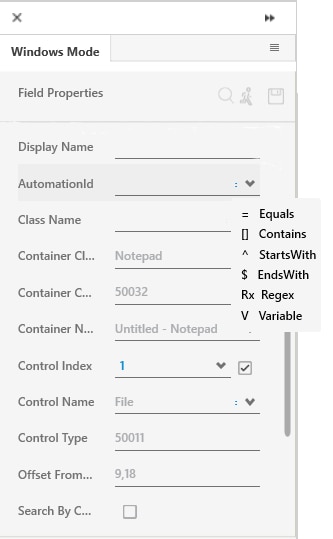
Use the  (drop down arrow) icon to reconfigure the identification criteria. Available options are:
(drop down arrow) icon to reconfigure the identification criteria. Available options are:
- Equals- Identifies the UI element based on the exact match with the value of the selected field property.
- Contains- Identifies the UI element based on the string present in the value of the selected field property.
- StartsWith- Identifies the UI element based on the starting string of the value of the selected field property.
- EndsWith- Identifies the UI element based on the ending string of the value of the selected field property.
- Regex- Identifies the UI element with the string matching the value of the selected field property as per the identification pattern defined through the provided regular expression such as a.b, *txt and others.
- Variable- Identifies the UI element as per the parametrization of the value of the selected field property value. Parametrization allows to run the identification process over and over again using different values. With parameterization, windows controls with looping and assignment activities, are used.
Application Host Properties
The properties of the Application Host activity are listed in the following table and can be edited in the Property grid on the right pane.
|
Property Name |
Usage |
|
Control Execution |
|
|
Ignore Error |
When this option is set to Yes, the application ignores any error while executing the activity. If set to NA, it bypasses the exception (if any) to let the automation flow continue; however, it marks the automation status as failure, in case of an exception. By default, this option is set to No. |
|
Delay |
|
|
Wait After |
Specify the time delay that must occur after the activity is executed. The value must be in milliseconds. |
|
Wait Before |
Specify the time delay that must occur before the activity is executed. The value must be in milliseconds. |
|
Misc |
|
|
AppType |
The plugin that gets attached to the host application depending on the type of host application. |
|
Breakpoint |
Select this option to mark this activity as the pause point while debugging the process. At this point, the process freezes during execution allowing you to examine if the process is functioning as expected. In large or complex processes, breakpoints help in identifying the error, if any. |
|
Commented |
Select this option to mark this activity as inactive in the entire process. When an activity is commented, it is ignored during the process execution. |
|
DisplayName |
The display name of the activity in the flowchart designer. By default, the name is set as the name of the selected application. You can change the name as required. |
